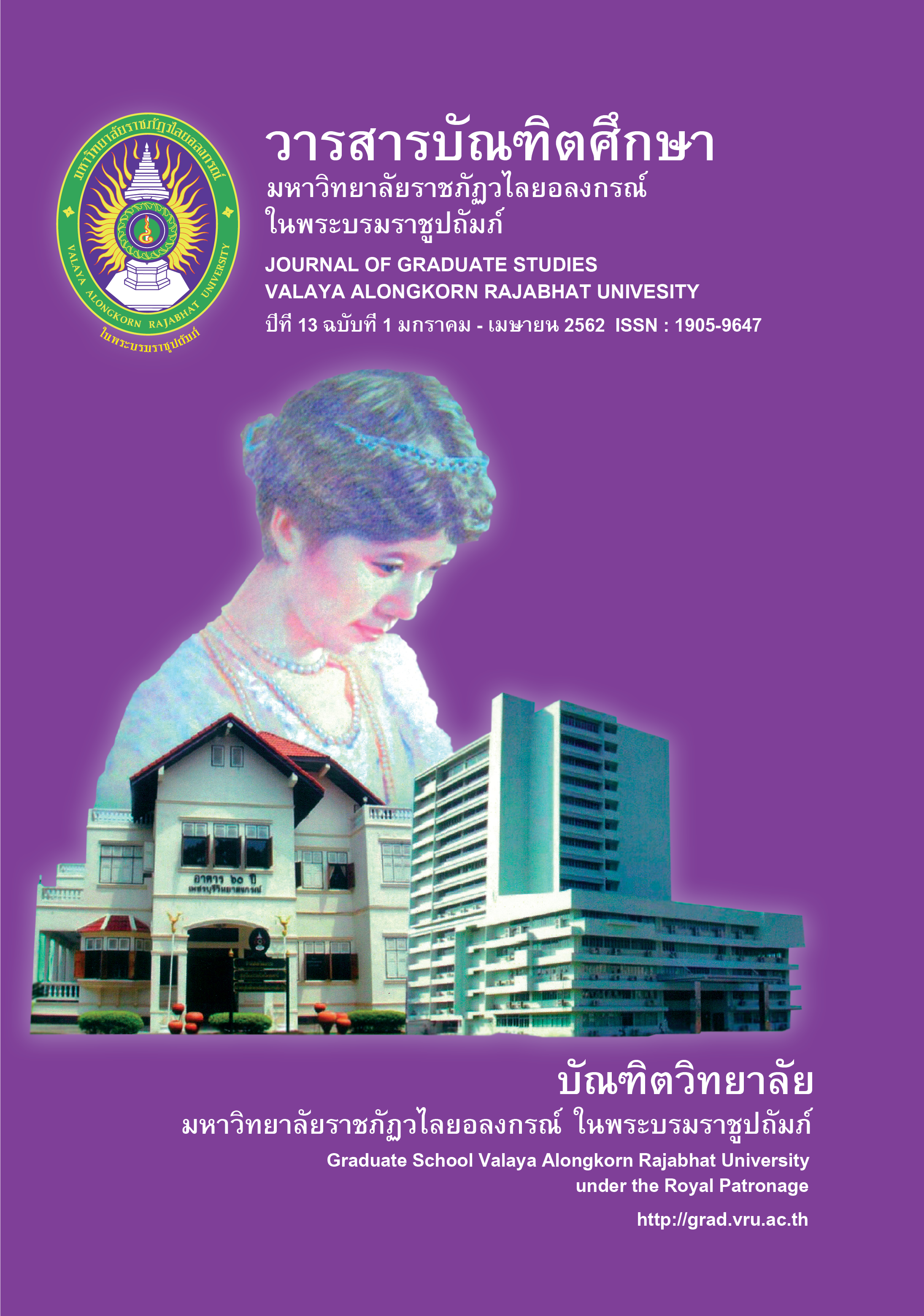A STUDY OF THE MODEL OF COMMUNICATION FOR THE MANAGEMENT OF SUSTAINABLE TOURISM COOPERATION IN PATHUM THANI PROVINCE
Main Article Content
Abstract
This study is an integrated research which had the objectives as follows: 1) to study the model of communication for the management of sustainable tourism cooperation in all sectors in Pathum Thani province, and 2) to propose the model of communication for the management of sustainable tourism cooperation in all sectors in Pathum Thani province. The researchers conducted a survey of historical tourist attractions in Pathum Thani which included 9 temples as follows: Wat Boat, Wat Chinwararam, Wat Chedihoy, Wat Sarnchao, Wat Hongpathummawat, Wat Sing, Wat Saladangnua, Wat Songpinong and Wat Bangna. A survey concerned with 400 participants who were tourists and people living in Pathum Thani. The instrument in this study consisted of questionnaire, interview, observation, focus group discussion and public hearing. The validity of the instrument (IOC) was 0.8 and the reliability was 0.76 the statistics for analysis were percentage, frequency, mean, standard deviation and multiple regression.
The findings of this study were as follows:
- The level of opinions of the public towards the model of communication was found as a whole at the highest level (
= 4.23, S.D. = 0.76) Considering each aspect, the levels of opinion were arranged from high mean to low mean as follows: the model of communication classified by ways of communication, the model of communication classified by communication channel, and the model of communication classified by characteristics of communication.
- Overall, the level of opinions of the public towards tourism management was at the highest level (
= 4.32, S.D. = 0.72). As for each aspect, the results from the highest level were as follows: tourism management related to environment, tourism management related to economics and tourism management related to society and culture.
- The level of opinions of the public towards sustainable tourism cooperation was found as a whole at the highest level (
= 4.35, S.D. = 0.70) Concerning each aspect, in order of high level to low level, the results were as follows: sustainable tourism cooperation in terms of the development of tourism consciousness, sustainable tourism cooperation in terms of the development of tourism resources, sustainable tourism cooperation in terms of the development of environment in tourist attractions and tourism business.
- The model of communication correlated with tourism management; and the model of communication and tourism management were significantly correlated with sustainable tourism at the level of .05
- The communication model of Pathum Thani cooperative sustainable tourism management was one form that had its own direction. For example, to communicate from top to bottom, bottom to top, and horizontal direction. In addition, the one way and two way direction were another forms of the place’s communication, which would support the tourism management in order to receive the organization’s collaboration through both performances and activities. This included the tourism location would be promoted, that resulted to provide the cooperative tourism in long run.
Article Details
บทความทุกเรื่องได้รับการตรวจความถูกต้องทางวิชาการโดยผู้ทรงคุณวุฒิ ทรรศนะและข้อคิดเห็นในบทความวารสารบัณฑิตศึกษา มหาวิทยาลัยราชภัฏวไลยอลงกรณ์ ในพระบรมราชูปถัมภ์ มิใช่เป็นทรรศนะและความคิดของผู้จัดทำจึงมิใช่ความรับผิดชอบของบัณฑิตวิทยาลัย มหาวิทยาลัยราชภัฏวไลยอลงกรณ์ ในพระบรมราชูปถัมภ์ กองบรรณาธิการไม่สงวนสิทธิ์การคัดลอก แต่ให้อ้างอิงแหล่งที่มา
References
Chitthawattana, B. & Sikhamapa, P. (2014). kānphatthanā kānthō̜ngthīeo bǣp yangyư̄n [Sustainable tourism development]. 2nd ed. Bangkok: Dharmasarn Printing Company Limited.
Esichaikul, R. (2014). kānčhatkān kānthō̜ngthīeo chapho̜ thāng [Niche tourism management]. Nonthaburi: The Office of the University Press Sukhothai Thammathirat Open University.
Gambl, T. K. & Gamble, M. (1999). Communication works. 6th ed. Boston: McGraw-Hill.
Hintow, B. (2010). rūpbǣp kānsư̄sān yāng mī sūan rūam khō̜ng chāobān phư̄a kānčhatkān pā chumchon yāng yangyư̄n kō̜ranī pā chumchon tambon ʻibun ʻamphœ̄ lom sak čhangwat phet būn [A participatory communication patterns about sustainable community forest management: a case study of tambon tha-i-boon, lomsak district, Phetchabun province]. Phetchabun Rajabhat University.
Hunnark, C. (2016). kānphatthanā kānthō̜ngthīeo chœ̄ng prawattisāt nai čhangwat samut songkhrām [The development of historical tourism in Samut Songkhram province]. Academic Services Journal, Prince of Songkla University. 27(1), 39-46.
Mowforth, M. and Munt, l. (2009). Tourism and Sustainability: Development, Globalization and New Tourism in the third Word. 3rd ed. London: Routledge.
Ngamyingyong, N. & Silanoi, L. (2017). nǣothāng kānphatthanā kānthō̜ngthīeo yāng yangyư̄n chumchon bō̜riwēn rim fang khlō̜ng damnœ̄n sadūak nai čhangwat samut sākō̜n læ čhangwat rāt burī [Guidelines on sustainable tourism development at the lakhacommunity on the banks of damnoensaduak canal in samutsakhonand Ratchaburi provinces]. Dusit Thani College Journal. 11(1), 149-166.
Pongsakornrungsil, P. (2014). kānčhatkān kānthō̜ngthīeo chumchon yāng yangyư̄n : kō̜ranī sưksā bān khōk khrai čhangwat Phangngā [The management of sustainable community-based tourism: the case of ban kokekrai, phang nga province]. Journal of Education Veridian E-journal. 7(3), 650-665.
Sharpley, Richard. (2009). Tourism Development and the Environment: beyond Sustainability. London: Earth Scan.
Smith, A. G. (Ed.). (1966). Communication and culture: Reading in the codes of human interaction. New York: Holt, Rinehart & Winston.
Swasburi, O. & Komolsevin, R. (2009). rūpbǣp kānsư̄sān khō̜ng nakkānmư̄ang thō̜ngthin [Communication forms of local politicians]. University of the Thai Chamber of Commerce Journal Humanities and Social Sciences. 29(4), 41.
Wood, J. T. (2000). Communication in our lives. 2nd ed. Belmont, CA: Wadsworth.
Yamane, T. (1973). Statistic: An introduction analysis.3rd ed. New York: Harper and Row Publication.


